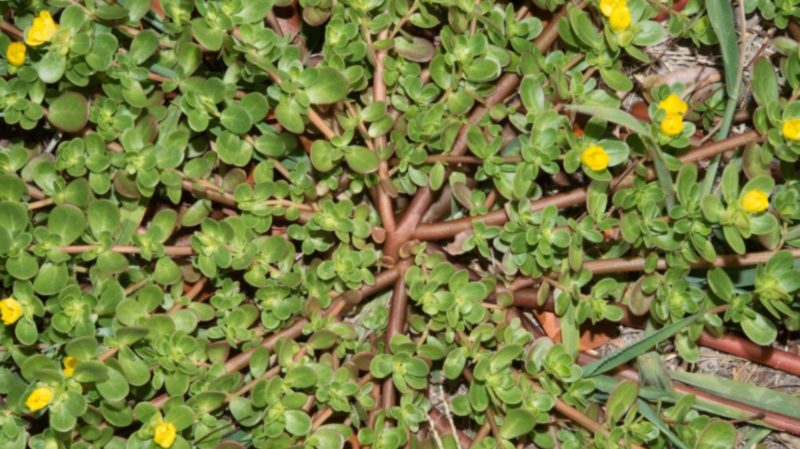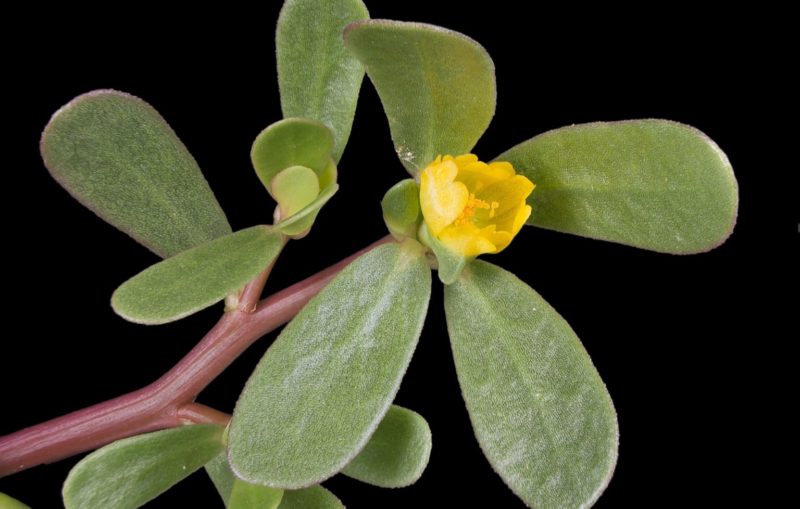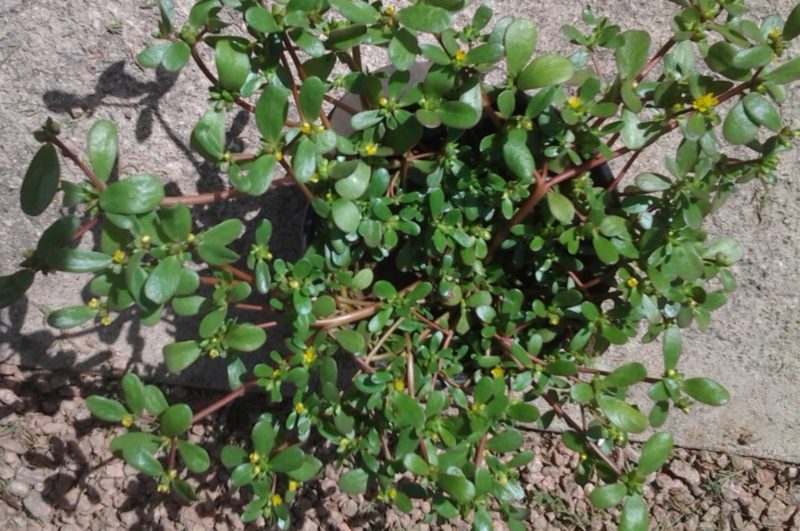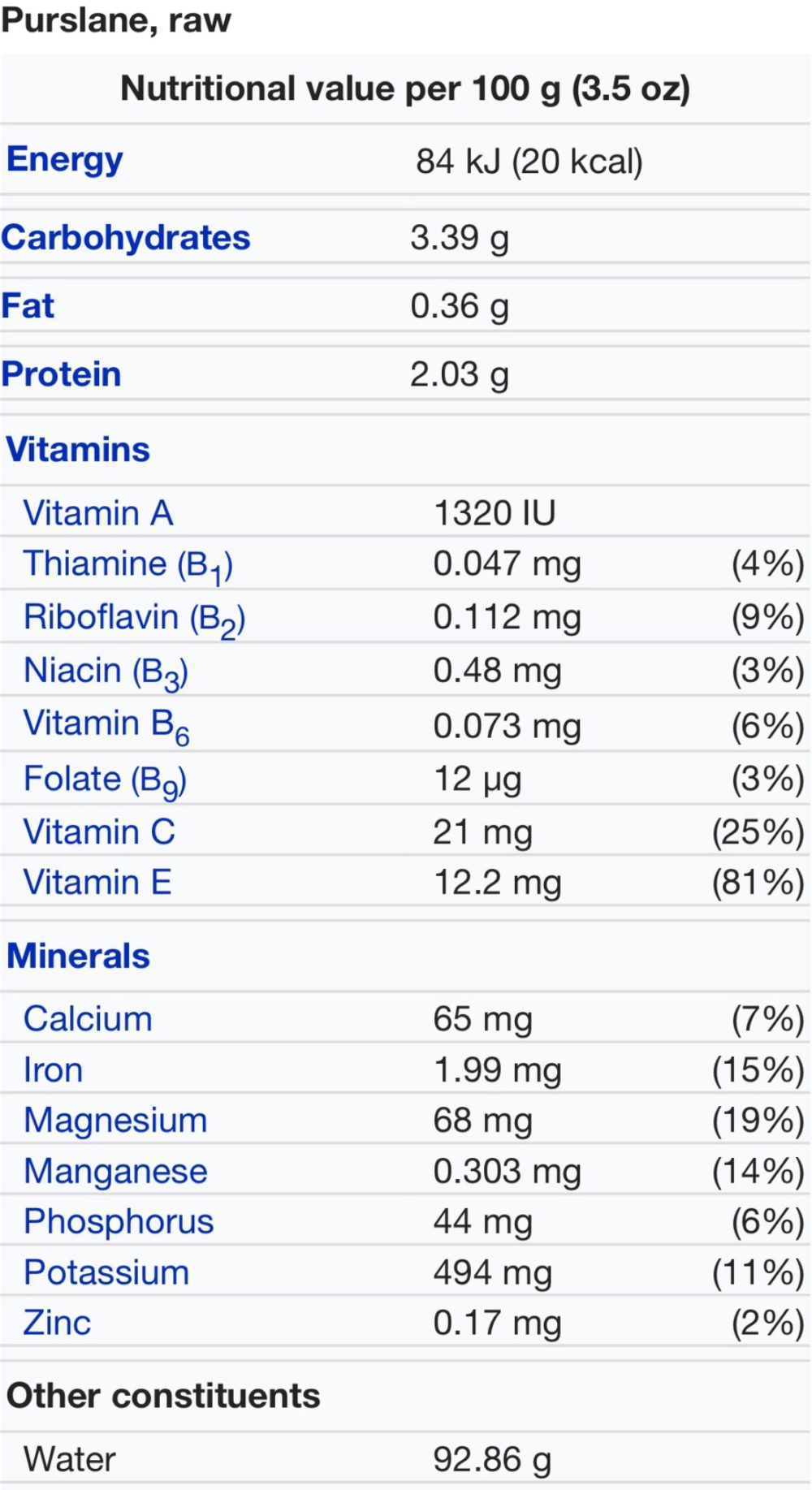Purslane, or more accurately, common purslane (Portulaca oleracea), is a very nutritious plant that is cultivated and/or grows as a weed throughout much of the world. Other common names include: pusley, pursley, verdolaga, little hogweed, red root, andrakla (αντράκλα), glystrida (γλυστρίδα), reglah (رجلة), Bakleh, burdullak, qulfa, baldroegas, sanhti, paruppu keerai, gangabayala kura, punarva, and kulfa, amongst many, many others.
Notable qualities of the plant, in addition to its tastiness, include: the fact that purslane contains more omega-3 fatty acids than any other leafy vegetable food; that it contains high levels of Vitamin E, Vitamin C, Magnesium, and Potassium; and that it’s very useful as a companion plant thanks to its deep, powerful taproot growth.
It’s cosmopolitan distribution is another very notable quality — with the plant growing practically everywhere in the temperate world. This cosmopolitan range-extent doesn’t seem, going by the evidence, to be a recent phenomenon — but rather to possibly stretch back into prehistory.
The species is classified as being part of the family Portulacaceae, can grow to be more than 16 inches tall, and can flower at any time of the year. Notably, the seeds are edible as well as the greens, but should probably be processed in the traditional ways (or good approximations) of those that ate them, such as various Australian Aboriginal peoples. This is so as to break down or remove some of the components which can potentially cause problems for people.
History, Distribution, & Speculation On Prehistory
Archaeobotanical finds of purslane and/or purslane seeds are common at prehistoric sites throughout the Mediterranean. Notable finds include seeds being found in a protogeometric layer in Kastanas, as well as from the Samian Heraion dating to seventh century BC.
With regard to accounts, Theophrastus noted purslane, andrákhne (ἀνδράχνη), as a summer pot herb that is best sown in April.
In India purslane is known by a variety of names (there are a lot of languages spoken on the Indian subcontinent), including: sanhti, paruppu keerai, gangabayala kura, punarva, and kulfa.
Interestingly, despite earlier assumptions that purslane was introduced to North America by the Spaniards, recent evidence shows that it was present throughout various parts of the continent before European colonization. And, also, that it was used as a food by a great many peoples, just as it was in many other regions of the world.
Which is quite interesting when you think about it — an edible, nutritious plant food that was growing in pretty much every part of the world that it could, and being eaten by people in every part that it was growing. Which brings up similar questions to those posed by the fact that there are 3 domesticated species of cotton — one that was domesticated in the northern part of South America, one that was domesticated near the Nile River in east Africa, and one that was domesticated in the Indus Valley. All of these are thought to have been domesticated around the same time period.
As far as speculation goes, I would be very surprised if trans-continental oceanic trade doesn’t go far further back into “prehistory” than is currently thought. And that the cosmopolitan presence of some very useful plants (with regard to use by humans) isn’t related to these earlier trade networks. (Nettles, as well, perhaps)
(Notably, a close relative of common purslane is actually native to South America, particularly to the drier parts of the southern part of the continent. I wonder what it’s descended from? Is there a “relatively” recent common ancestor to the two species?)
Culinary & Herbal Uses, Chemical Constituent Info, & Oxalic Acid Content
As far as the culinary uses of common purslane, the sour and salty quality of the greens and stems (which depends somewhat on the time of day harvested) lends itself well to salads. Purslane is used for a variety of other purposes as well though, including: in soups and stews, cooked (think of spinach), turned into seed-cakes (just the seeds obviously), and in baked pastries. The flower buds are edible as well, notably.
As mentioned above, owing to purslane’s use of the crassulacean acid metabolism (CAM) pathway, the time of day that it’s harvested has much to do with how tangy and sour it is.
To explain, the plant produces malic acid and oxalic acid through the CAM pathway, as many xerophytes do, when it’s water stressed, meaning that at night it’s leaves will trap carbon dioxide and covert it to magic acid, during the day this malic acid is then used to produce glucose. This pathway allows the plant to use less water during photosynthesis than as normally practiced. (Malic acid is most of what makes sour apples taste sour.)
As far as culinary use goes, it’s worth noting that raw purslane contains relatively high levels of oxalate (as spinach, and chards do as well) — up to 910 mg per half-cup reportedly. Cooking and discarding the water will, as with spinach and chard, reduce oxalate content significantly. While oxalate seems to have no direct (negative) affect on most people, it has been implicated in the formation of kidney stones.
Traditional medicinal uses of purslane (whether in Europe, Asia, or elsewhere) is pretty consistent — the plant leaves are used on sores, boils, insect bites, postpartum bleeding, and snake bites. Internal use varies somewhat, with a common use being the improvement of cognitive functioning — use is apparently contraindicated for those with weak digestions, and those that are pregnant.
Notably, purslane is considered to be a clinically effective treatment for oral lichen planus. Also notable, betacyanins isolated from purslane have been shown in research to improve cognitive deficits in old mice. Also, “a subclass of homoisoflavonoids from the plant showed in vitro cytotoxic activities towards four human cancer cell lines.”
Interestingly, research has shown that purslane is effective at removing bisphenol A (BPA) from a hydroponic solution. What this translates to in practice, in a human’s body, isn’t clear. (BPA is a potent endocrine disruptor.)
Purslane’s chemical constituents include: noradrenaline, calcium salts, dopamine, L-DOPA, malic acid, citric acid, asparagic acid, glutamic acid, nicotinic acid, betacyanins, alanine, glucose, sucrose, and fructose.
Common Purslane (Portulaca Oleracea) Nutrition Information
As noted at the start of the article, purslane contains more omega-3 fatty acids (alpha-linolenic acid in particular) than any other leafy vegetable yet studied. Also, research has shown that purslane has 0.01 mg/g of eicosapentaenoic acid (EPA).
There’s roughly 300 to 400 mg of alpha-linolenic acid in 100 grams of fresh purslane leaves.
The leaves and stems of the species also contain high levels of Vitamin E, Vitamin C, Magnesium, and potassium. Notable quantities of the various B Vitamins, Vitamin A, Calcium, and Iron, are also found.
In addition, two types of betalain alkaloid pigments are found in purslane — the “reddish betacyanins (visible in the coloration of the stems) and the yellow betaxanthins (noticeable in the flowers and in the slight yellowish cast of the leaves). Both of these pigment types are potent antioxidants and have been found to have antimutagenic properties in laboratory studies.”
Companion Planting & Harvesting
Thanks to its deep, powerful taproot growth purslane makes an excellent choice for companion planting. These deep taproots bring moisture up to the surface from relatively deep underground, and the ground-cover growing pattern of the species also helps to stabilize ground-level moisture and make the local microclimate more hospitable.
Very notably, the roots of some plants such as maize (corn) will actually follow behind purslane roots when growing in places with very hard soil. As the maize roots can’t easily penetrate soil that’s been heavily compacted, but purslane roots can, the “weed” purslane can actually notable improve local productivity in such situations.
More generally, plants with deep taproots also benefit their neighbors by bringing up minerals and carbon from deeper underground where the other plants may not be able to access it.
As mentioned above, the time of day harvested determines to a large extent how tangy the purslane is. Water stress plays a part in determining tanginess as well. Generally, the earlier in the day that purslane is harvest the more tang that there will be. In the early morning purslane leaves reportedly have up to 10 times more malic acid content than they do in the late afternoon.






